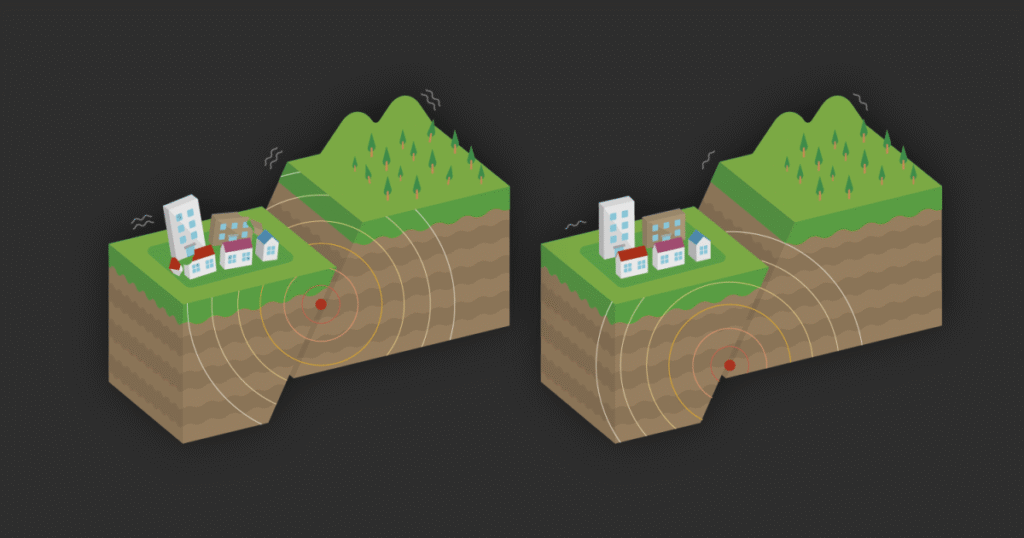A magnitude 6 earthquake struck eastern Afghanistan near the border with Pakistan just before midnight local time on Sunday, according to the United States Geological Survey. Several aftershocks followed.
At least 800 people were killed and 2,500 were injured. The epicentre of the earthquake was at a depth of about 8km (5 miles), which seismologists consider shallow, making the ground shaking more intense and destructive, particularly for fragile homes and communities.
Most earthquakes occur at shallow depths, and in this visual explainer, we show why those near the surface often cause more destruction than deeper ones, even when their magnitude is the same.

How do earthquakes happen?
An earthquake, in the simplest terms, happens when the Earth shakes.
The surface of the Earth is made of kilometres of hard rock broken into a puzzle of moving pieces called tectonic plates, which sit on a sea of hot, liquid rock that rolls as it cools, pushing the plates around. Earthquakes and volcanoes occur on the surface where these plates meet.
Plates are technically always in motion but are usually locked together, building stress until something underground snaps, freeing them to slide along known lines of fractured rock called faults, which can run for kilometres.
When the pressure suddenly releases and the plate moves, energy explodes into the surrounding rock.
How are earthquakes measured?
Scientists use seismographs, which used to be wiggling needles that record the ground’s shakes, but now the equipment is all digital.
There is a global network of these, as well as local and regional networks, and much of the data is open-source and automatically connected. By combining at least three measurements, systems can map the location, duration and size of an earthquake with precision.
While there are several ways to measure earthquakes, the most common scale refers to their overall magnitude, with each increase of one unit representing a tenfold increase in strength.
Depth is also a key factor, as it significantly influences the earthquake’s impact, with shallower quakes typically causing more damage.
Why are shallow earthquakes more destructive?
Even if two earthquakes have the same magnitude, their depths can make a big difference in how much damage they cause and how strongly they are felt on the surface. Shallower quakes tend to be much more destructive because their energy has less distance to travel before reaching people and buildings.
In deeper earthquakes, much of the energy dissipates as it moves through layers of rock. By contrast, shallow ones release their energy closer to the ground, producing stronger shaking and greater damage in populated areas.
There are typically three measurements used to classify earthquake depth: shallow focus (0-70 km or 0-43 miles), intermediate focus (70-300 km or 43-186 miles), and deep focus (300-700 km or 186-435 miles).
Where do most of Afghanistan’s earthquakes occur?
Afghanistan sits in one of the most active seismic zones on Earth, with the Hindu Kush mountain range a hotspot for both shallow and deep earthquakes. This area is highly active due to the tectonic collision between the Indian Plate and the Eurasian Plate.
This immense pressure crumples and fractures the crust, while in the Hindu Kush it also drives parts of the lithosphere to sink steeply into the mantle. As a result, the Pamir-Hindu Kush region of northern Afghanistan witnesses intense earthquakes, reaching depths of up to 200km (124 miles) – a rare phenomenon globally.
In contrast, along the Sulaiman Range (western Pakistan and southeastern Afghanistan) and near the Main Pamir Thrust, earthquakes are typically shallow and destructive, striking closer to the surface where they cause the most damage.
The graphic below shows where some of the deadliest earthquakes have occurred across Afghanistan since 1991.
https://www.aljazeera.com/news/2025/9/1/why-do-shallow-earthquakes-cause-more-destruction-than-deep-ones?traffic_source=rss


